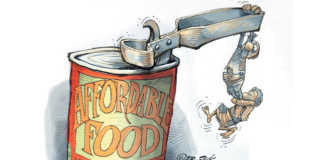Feeding the world’s population during the next 40 years will be a remarkably tough challenge. Time is running out; there is no central authority to take charge and public policies are generally myopic. What is more, it is usually assumed that solving the problem is the role of governments, NGOs, the UN and various charities. Agribusinesses are seen as part of the problem, pursuing short-term gains at the expense of human development and the environment.
However, private sector market-driven solutions are an essential component to meeting the challenge, not least because agribusiness leaders have begun to recognise both the moral and practical dimensions of their role. Louise Fresco, in New Agriculturalist, writes: “They realise that it’s not just about profits and it’s not just about keeping shareholders happy. It’s really about having a licence to produce and being acceptable in society and investing in the long term.”
Creativity
Based on a literature review and interviews with a panel of 24 agribusiness experts, we have identified seven key barriers that impede the world’s ability to feed more people. We also focus on the ways that agribusinesses can help to bring together the creativity, determination and technology needed to recreate Brazil’s ‘Miracle of the Cerrado’ on a global scale.
Government
The World Bank estimates that African farmers can grow enough food to feed the continent if governments agree to lift cross-border restrictions, simplify the rules and fees involved in food trade, and permit uncultivated land to be put into use.
Government policies and regulations often increase the costs of establishing and operating a business, and are frequently most burdensome in the regions where growth is most needed. Even in Brazil, setting up a business
takes 119 days, whereas in Australia it takes just two.
Also, as National Turkey Federation president Joel Brandenberger points out, there is “a fundamental misunderstanding of the scope of the looming hunger problem” and “an unrealistic faith” in the regulation of conventional food production, while judging the value of new technologies taxes the resources of governments. While there are limits to how much agribusinesses can affect government regulations and corruption, participation by and pressure from the business community can make a difference in both areas.
Losses
According to the UN’s Food and Agriculture Organisation (FAO), a third of all food is lost, with consumers in Western Europe and North America wasting upwards of 10 times as much as those in sub-Saharan Africa. In low-income regions, the loss is due largely to harvesting techniques and poor post-harvest storage and marketing. These are all areas in which agribusinesses have substantial expertise.
Infrastructure
This determines how quickly feed, ingredients and food products can move through the supply chain to the end-user. In the USA, successive governments have failed to reinvest in the existing infrastructure, leading to a relative loss in this competitive advantage.Agribusinesses can sometimes build the necessary infrastructure themselves, or use their influence to encourage government or public-private investment. At the same time, firms can work together to streamline the supply chain.
Markets
In many regions, fragmented markets and dependence on middlemen make it difficult for agribusinesses to develop efficient operations, and thus act as a constraint on growth and maximisation of resources. While there are examples of agribusiness operations working together to reduce volatility and stabilise the markets for the farmer (such as when French farmers and McDonald’s sign multi-year contracts), these are too few.
Policies
Sometimes, policies support wasteful use of resources. For example, fertile land in Russia and Argentina lies fallow because of volatile government policies, while subsidies encourage crops and herds that would otherwise be unsustainable. The USA and the EU spend billions annually on agricultural subsidies, distorting the value of crops grown and the markets for those crops. Agribusiness leaders could do more to help develop ‘best practice’ policies that take into account the specific needs of a given sector as well as the impact on the larger environment.
Science/Innovation
The effectiveness of the chemical arsenal is declining. Antagonism between society and scientists has created barriers to the acceptance of genetically modified organisms. Biofuel technology has led to the diversion of food to fuel and competition for farmland, creating a backlash that may obscure the value of the second-generation work that is now being done. These obstacles are not new. As Nobel Laureate Norman Borlaug, one of the leading scientists behind the ‘Green Revolution’ of the 1970s, has noted: “We confronted bureaucratic chaos, resistance from local seed breeders, and centuries of farmers’ customs, habits, and superstitions. We surmounted these difficult obstacles because something new had to be done.
“Who knows how many would have starved if we had delayed commercialising the new high-yielding grain varieties and improved crop management practices until we could perform tests to rule out every hypothetical problem, and test for vulnerability to every conceivable type of disease and pest? How much land for nature and wildlife habitat, and topsoil, would have been lost if the more traditional, low-yield practices had not been supplanted?”
Innovation is a challenging area to which agribusinesses – individually and collectively – have a tremendous amount to contribute. The research that leaders in all agribusiness sectors are already pursuing contains the seeds of the next ‘Green Revolution’.
Environment
Resource issues, and the implications for the environment, are among the challenges most often cited by the agribusiness community. Taken together, the availability of arable land, security of tenure and degradation of land comprise one of the biggest resource issues. For example, it has been estimated that there is a need for 30% more grain from the fast-reducing stock of arable land. Greater productivity is one answer. Another is making better use of marginal land. These are areas where pro-active agribusiness interests are already making a difference.
Similarly, lack of clean water, a problem that was typically associated with specific regions, has recently been recognised as a global issue and called the ‘silent crisis’. On the one hand, agribusinesses are often seen as part of the problem, through over-fishing, over-harvesting, use of chemicals and pesticides, and similar practices. On the other, there is the challenge of producing more food from more difficult environments. These are areas in which innovation, creativity and the desire to succeed, all characteristic of the private sector, can be used advantageously.
Opportunities
In short, agribusinesses can play a crucial role in addressing some of the major challenges in feeding a bigger population, especially when it comes to infrastructure, markets and the environment. The expertise and innovation required for agribusinesses to survive in the competitive marketplace can be applied to these challenges in ways that contribute to both the organisation and the greater good.
Agribusinesses can anticipate, recognise and work to overcome government bureaucracy and corruption. They can build credibility with consumers by being more open about the science of innovation and by working to help shape policy in ways that contribute to larger goals, not simply narrow self-interest. By taking a long-term perspective, and developing working relationships across boundaries, agribusinesses can help reduce losses through their supply-chain expertise.
However, all these aspects need people to deal with them, and many experts we spoke to emphasised the importance of education, especially for women. As noted by researchers Mary Shelman and Aidan Connolly in 2012, the ‘glue’ that will define the success of agribusiness organisations is not physical resources or financial clout, but “human capital”.
Conclusions
Larry Elliott, economics editor of The Guardian, writes: “The current assumption seems to be that the world can have a rising population, ever-higher per capita meat consumption, devote less land to food production to help hit climate change targets and eschew the advances in science that might increase yields. This is the stuff of fantasy.
“It is possible to have more intensive farming using the full range of technological breakthroughs in order to feed a bigger, meat-hungry population. Or it is possible to have lower yields from a more organic approach to feed a smaller population eating less meat, but not both.” This captures the essence of the problems of feeding a growing global population. But it should be clear that the barriers and opportunities to achieving the necessary growth are often two sides of the same coin.
According to the FAO, an additional one billion tons of cereal and 200 million tons of meat will be required by
mid-century. Building on evidence that agricultural productivity has improved by 2,6% a year over the past 10 years, it estimates that productivity will increase a further 1,7% a year for the next 10. Clearly, it is possible to achieve the necessary growth and, given the creativity and determination within the agribusiness community, the biggest barrier, arguably, is not recognising the opportunities within the obstacles.
Adapted from a 2012 International Food and Agribusiness Management Review paper by Aidan Connolly and Kate Phillips-Connolly.
The views expressed in our weekly opinion piece do not necessarily reflect those of Farmer’s Weekly.













